Wacom CTE-450 Owner's Manual
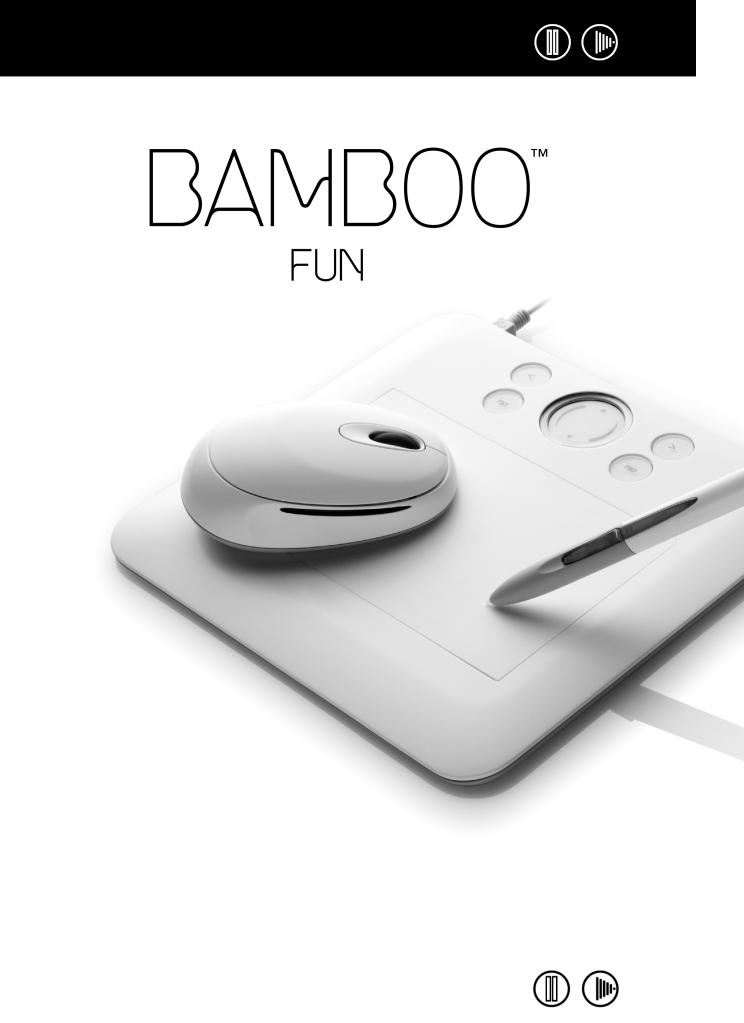
Contents Index
1
User’s manual for
Windows® & Macintosh®
Using a pen
Customizing your pen
Troubleshooting
Using a tablet
Customizing your tablet
Digital inking
Using a cordless mouse
Customizing your cordless mouse
Contents Index
1

Contents Index
2
Bamboo™ Fun
User’s Manual for Windows® & Macintosh®
English version 1.0, April 03, 2007
Copyright © Wacom Company, Limited, 2007
All rights reserved. No part of this manual may be reproduced except for your express personal use. Wacom reserves the right to revise this publication without obligation to provide notification of such changes. Wacom does its best to provide current and accurate information in this manual. However, Wacom reserves the right to change any specifications and product configurations at its discretion, without prior notice and without obligation to include such changes in this manual.
 Reuse, recycling, and recovery. You are urged to recycle this product when replacing it with a newer product or when it has outlived its useful life by bringing it to an appropriate collection point for recyclable materials in your community or region. By doing this, you can help improve the environment of your community as well as minimize the potential negative effects created should any hazardous substance that may possibly be present within waste material reach the environment during the disposal process.
Reuse, recycling, and recovery. You are urged to recycle this product when replacing it with a newer product or when it has outlived its useful life by bringing it to an appropriate collection point for recyclable materials in your community or region. By doing this, you can help improve the environment of your community as well as minimize the potential negative effects created should any hazardous substance that may possibly be present within waste material reach the environment during the disposal process.
Within the European Union, users are required not to dispose of Waste Electrical and Electronic Equipment (WEEE) as unsorted municipal waste, according to the Directive 2002/96/EC of the European Parliament and of the Council of 27 January 2003, or the corresponding local laws of the Member States. Products for which this is applicable will be marked with the WEEE symbol shown at the beginning of this note unless this is not feasible because of the size or the function of the product. Wacom products are subject to the Directive 2002/96/EC and therefore you should always collect them separately and bring them to the appropriate collection point in your community or region.
Wacom pen tablet products comply with the European Union RoHS Directive 2002/95/EC (RoHS Directive).
Bamboo is a trademark and Wacom is a registered trademark of Wacom Company, Limited.
Adobe, Reader, and Photoshop are either registered trademarks or trademarks of Adobe Systems Incorporated in the United States and/or other countries. Microsoft, Windows, and Vista are either registered trademarks or trademarks of Microsoft Corporation in the United States and/or other countries. Apple, the Apple logo, and Macintosh are registered trademarks of Apple Computer, Inc., registered in the U.S. and other countries. Any additional company and product names mentioned in this documentation may be trademarked and/or registered as trademarks. Mention of third-party products is for information purposes only and constitutes neither an endorsement nor a recommendation. Wacom assumes no responsibility with regard to the performance or use of these products.
ExpressKey is a registered trademark of Ginsan Industries, Inc., and is used with permission.
Contents Index
2

Contents
About the manual
Navigating the manual
WORKING WITH BAMBOO FUN Tablet features
Input tools
Setting up your work area Using the cordless pen
Holding the pen About the active area Pointing
Clicking
Dragging
Using the pen buttons
Drawing with pressure sensitivity Erasing
Eye-hand coordination exercise Using the cordless mouse Working with the tablet
Using the ExpressKeys
Using the Touch Ring
CUSTOMIZING
Opening the control panel Control panel overview Control panel settings
Customizing the pen
Adjusting tip feel, eraser feel, and double-click
Customizing the pen buttons Button functions
Customizing the cordless mouse Customizing the mouse buttons
Tablet tracking
Mapping to multiple monitors Portion of screen area Portion of tablet area Setting mouse speed
Customizing the tablet functions Customizing the Pop-up Menu
Index
3
CONTENTS
4 |
TROUBLESHOOTING |
36 |
|
5 |
Testing your tablet and tools |
37 |
|
6 |
Troubleshooting tables |
39 |
|
General problems |
39 |
||
6 |
|||
Windows-specific problems |
42 |
||
7 |
|||
Macintosh-specific problems |
42 |
||
8 |
|||
Technical support options |
43 |
||
9 |
|||
Obtaining driver downloads |
44 |
||
9 |
|||
|
|
||
10 |
APPENDIX |
45 |
|
11 |
Pen and digital ink capabilities in Windows Vista |
46 |
|
12 |
About the Windows Vista Tablet PC Input Panel |
47 |
|
12 |
Caring for your tablet and tools |
48 |
|
13 |
Replacing the pen tip |
48 |
|
14 |
Uninstalling the tablet software |
49 |
|
14 |
Product specifications |
50 |
|
15 |
General specifications for |
|
|
16 |
all Bamboo Fun pen tablets |
50 |
|
Small Bamboo Fun tablet (model CTE-450) |
50 |
||
17 |
|||
Medium Bamboo Fun tablet (model CTE-650) |
50 |
||
18 |
|||
Bamboo Fun pen (model EP-155E) |
51 |
||
19 |
|||
Bamboo Fun cordless mouse (model EC-155) |
51 |
||
20 |
|||
Product information |
52 |
||
20 |
|||
Ordering parts and accessories |
52 |
||
21 |
|||
Radio and television interference |
53 |
||
21 |
|||
FCC notice |
53 |
||
22 |
|||
Industry Canada (Canada only) |
53 |
||
|
|||
23 |
CE declaration |
53 |
|
License and Warranties |
|
||
24 |
|
||
(Worldwide, Except for Europe, |
|
||
25 |
|
||
Africa and Middle East) |
54 |
||
28 |
|||
Software License |
54 |
||
29 |
|||
Limited Warranty |
54 |
||
30 |
|||
Warranty Service in the U.S.A. and Canada |
55 |
||
32 |
|||
Warranty on Sales Outside of |
|
||
32 |
|
||
the U.S.A. and Canada |
56 |
||
33 |
License and Warranty |
|
|
33 |
(Europe, Africa and Middle East) |
57 |
|
34 |
Software License Agreement |
57 |
|
35 |
Entitlement to Use the Software |
57 |
|
|
Limited Warranty |
57 |
|
|
GLOSSARY |
59 |
|
|
INDEX |
61 |
Contents Index
3

Contents Index
4
ABOUT THE MANUAL
This manual provides quick access to information about Bamboo Fun. Click on a navigation button or highlighted word to move through the document. The information is common to Windows and Macintosh computers and Windows screen captures are shown, unless otherwise noted.
•In the contents you can go directly to a topic by clicking on it.
•Working with Bamboo Fun is the learning chapter. It describes the pen tablet, the features and function of each Bamboo Fun tool, and includes exercises for new users.
•Customizing describes how you can change the control panel settings to optimize your Bamboo Fun pen, mouse, and tablet for the way you like to work.
•Want to test your tablet and tools? Need troubleshooting guidelines? Troubleshooting is where you will find the answers to most common questions.
•The appendix includes a variety of information: an overview of the new pen and digital inking capabilities found in Microsoft Windows Vista, tips on caring for your tablet and tools, a how-to on uninstalling the software, your license and warranty, and more.
Note: This manual does not contain information on installing your tablet. Please refer to your product Quick Start Guide and to the automated software installer (located on the Bamboo Fun Pen Tablet Driver CD) for complete details on installing your pen tablet.
If you are new to electronic documentation, be sure to read navigating the manual.
•SMALL CAPITAL LETTERS are used to identify the names of keyboard keys, dialog boxes, and control panel options.
•You can use your viewer zoom-in tool to increase the size of the manual on your display screen.
•The following information is not included with this product: information about your specific computer hardware or operating system, or information about your application software. Your best source for this information is the set of manuals and disks that came with your hardware, operating system, or application.
•Many applications have built-in support for Bamboo Fun features (such as pressure sensitivity
and the pen eraser). See product information for a listing of applications that support these features. For information on how best to use Bamboo Fun features within a specific application, see the instructions in that application’s manuals.
Contents Index
4
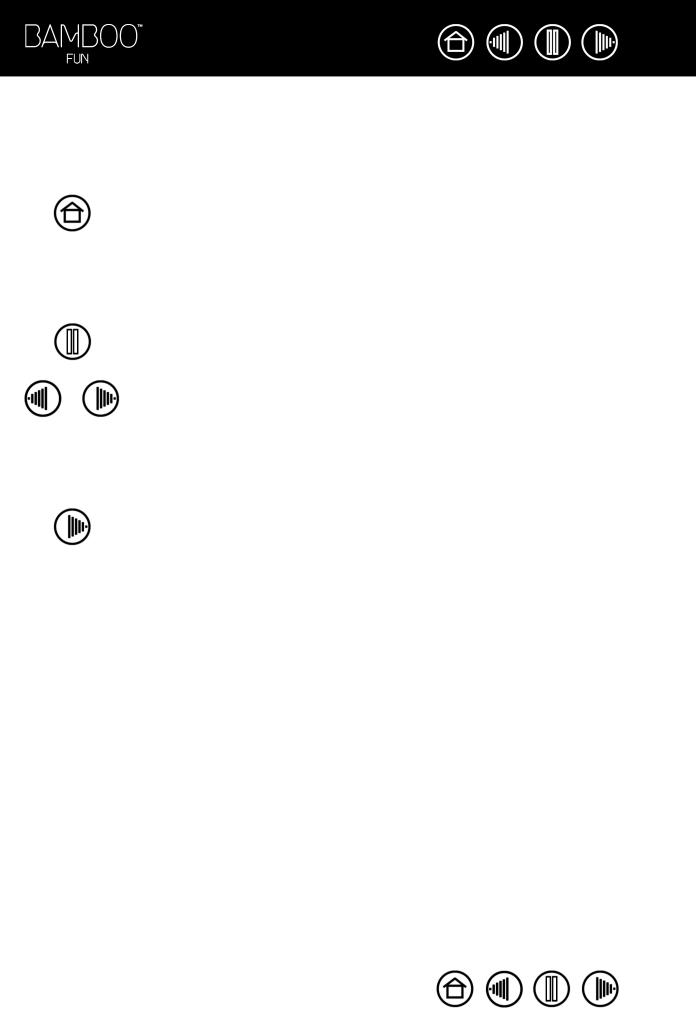
Contents Index
5
NAVIGATING THE MANUAL
Use the navigation controls to move through the manual:
Go to front page.
Go to table of contents.
Go to index.
Go back to previous view.
Page back, or page forward.
Go to beginning of section.
Go to topic.
Topic continued.
Adobe Reader provides you with additional tools for using and printing the manual. See the Adobe Reader help for more information.
Contents Index
5
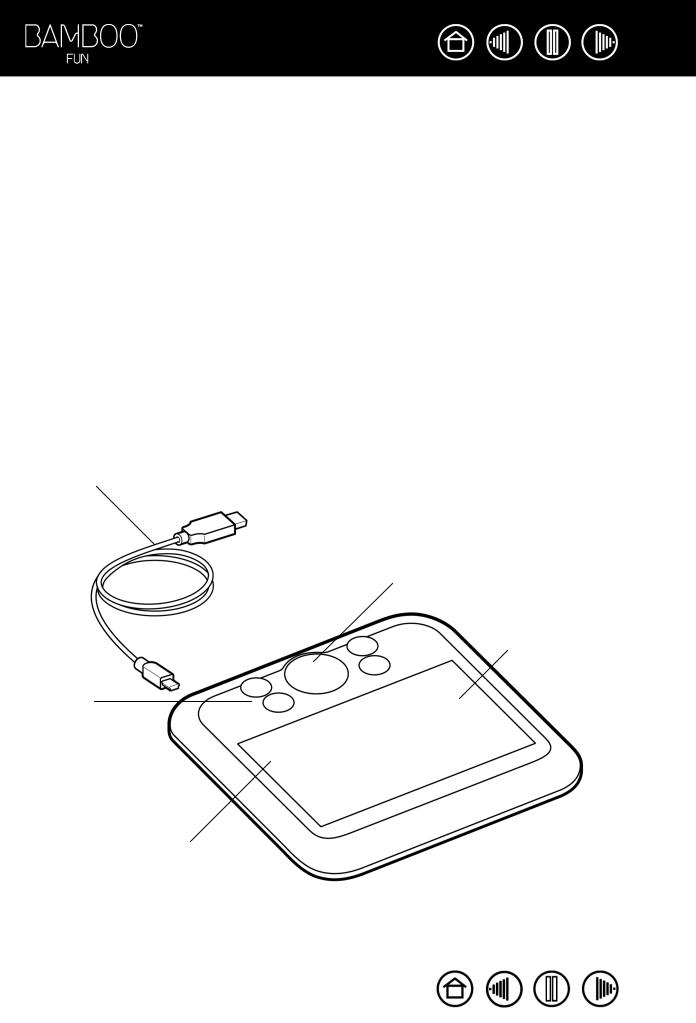
Contents Index
6
WORKING WITH BAMBOO FUN
This section introduces you to the Bamboo Fun pen tablet, which consists of two basic elements: a tablet that serves as your work area, and the input tools you use on the tablet.
If you are new to using a pen tablet and tablet input tools, read the following sections.
Tablet features Input tools
Setting up your work area Using the cordless pen Using the cordless mouse Working with the tablet
TABLET FEATURES
Detachable USB cable.
ExpressKeys.
See working with the tablet and customizing the tablet functions.
Touch Ring. A backlit status ring surrounds the customizable Touch Ring, and glows when the tablet power is on.
•Standby mode. The ring slowly pulses at a low light level.
•Active mode. The ring glows constantly at a brighter light level.
Active area. See about the active area.
Clear plastic overlay.
Contents Index
6
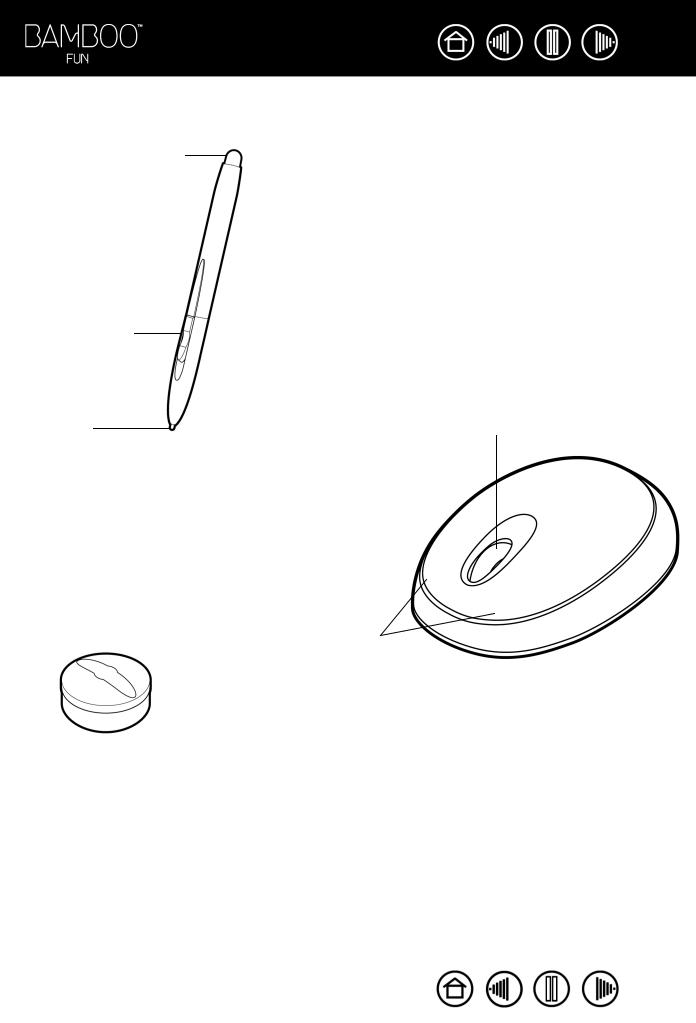
Contents Index
7
INPUT TOOLS
Your Bamboo Fun input tools are cordless and battery-free.
Eraser.
Bamboo Fun pen.
A pressure-sensitive freehand tool for image editing and creating natural-looking pen strokes. It is also efficient for document annotation and taking notes in applications that support handwriting recognition.
Pen buttons.
Replaceable nib (pen tip).
Programmable buttons can be customized.
Pen stand.
Fingerwheel. The integrated middle button and rolling wheel can be used for up and down scrolling in the active window. It can also be customized for a variety of button functions.
Bamboo Fun cordless mouse. An ideal tool for navigation or
performing any other task you may have done previously with a standard mouse.
Note: Some product configurations may not include the cordless mouse.
Contents Index
7
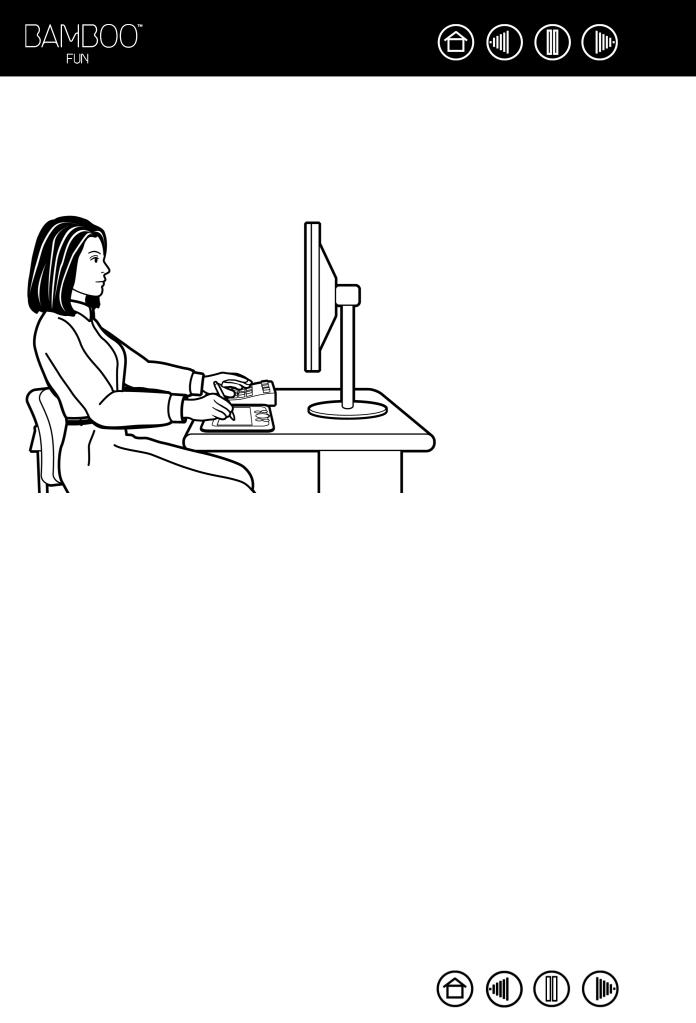
Contents Index
8
SETTING UP YOUR WORK AREA
To minimize fatigue, organize your work area so you can work comfortably. Position your tablet, input tools, and keyboard for easy access without unnecessary reaching. Position your monitor so you can view it comfortably with a minimum of eyestrain. For best results, orient the tablet so the screen cursor follows the same direction as your hand movements on the tablet.
• Take short breaks between tasks to stretch and relax your muscles.
• Use a gentle grip when working with your tools.
• Alternate tasks and tools throughout the day.
• Maintain a good posture at all times. Minimize awkward postures and repetitive movements that cause discomfort.
• Change your position if you feel any discomfort due to your work position.
Note: Wacom makes no representation, promise or guarantee that Wacom products will cure or prevent, in whole or in part, mouse-induced repetitive stress symptoms, injuries or conditions. Individual results may vary. Always obtain competent medical advice to determine the most appropriate treatment for your specific situation.
See working with the tablet for more information.
Contents Index
8
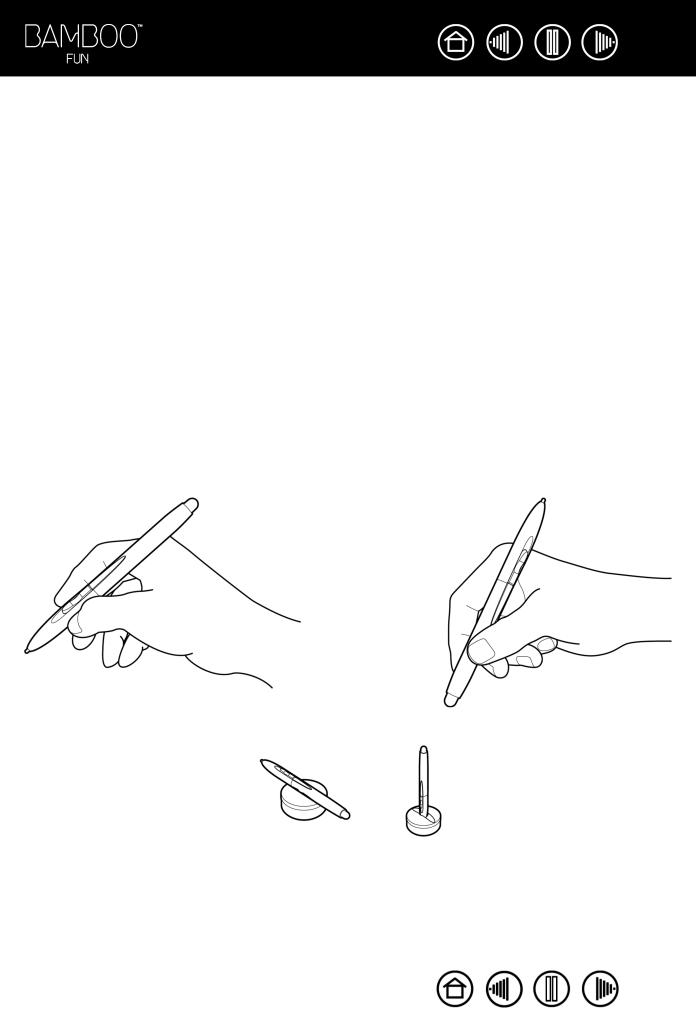
Contents Index
9
USING THE CORDLESS PEN
There are four basic techniques for using the pressure-sensitive pen: pointing, clicking, double-clicking, and dragging. If you are unfamiliar with using the pen, try the exercises on the following pages.
Holding the pen
About the active area
Pointing
Clicking
Dragging
Using the pen buttons
Drawing with pressure sensitivity
Erasing
Eye-hand coordination exercise
HOLDING THE PEN
Hold the Bamboo Fun pen like you would a normal pen or pencil. Make sure the pen buttons are in a convenient location where you can toggle them with your thumb or forefinger, but not accidently press them while drawing or navigating with the pen. Tilt the pen in any way that feels most comfortable.
Position for drawing and navigating.
Position for erasing.
Use the pen stand to store the pen between tasks. The stand allows vertical or horizontal placement of the pen.
Important: When the pen is not in use, place it in the pen stand or lay it flat on your desk. To maintain the sensitivity of your pen tip, do not store the pen in a container where it will rest on its tip. Leaving a Bamboo Fun tool on the tablet may interfere with screen cursor positioning when using other pointing devices. Also, leaving a Bamboo Fun tool on the tablet when not in use can prevent your computer from going to sleep.
Contents Index
9
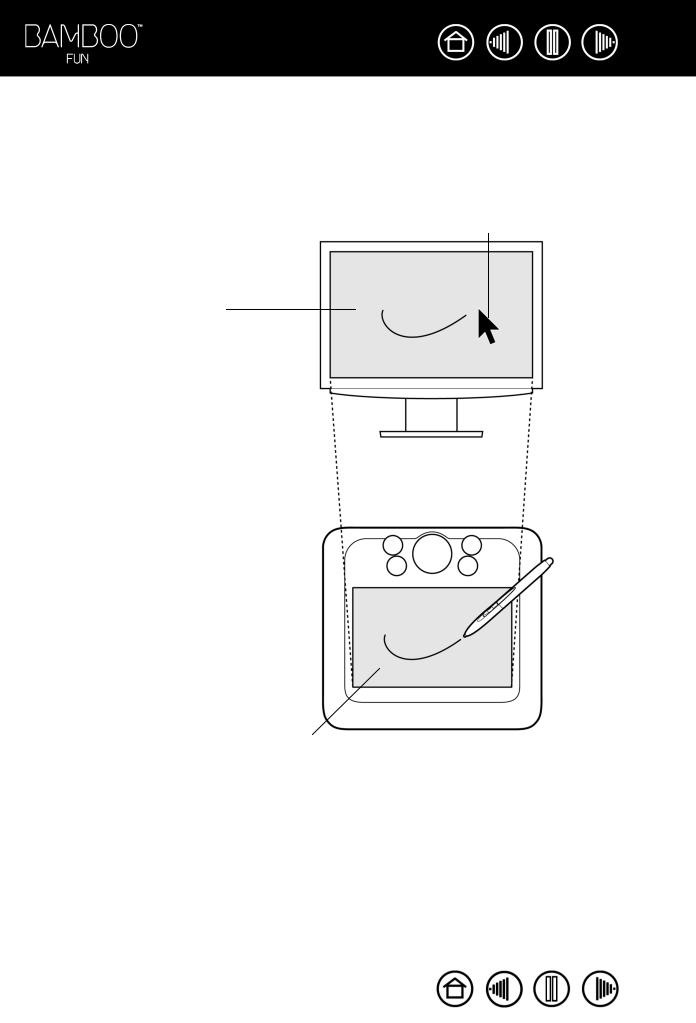
Contents Index
10
ABOUT THE ACTIVE AREA
The active area is the area of the tablet that senses pen movement. The screen area is the corresponding area on the screen.
The tablet active area is a mapped representation of your computer screen (a one-to-one relationship), and uses the entire screen. Wherever you place the pen on the tablet, the screen cursor will jump to the corresponding point on the screen. This is the default setting for the pen.
Pointer.
Screen area.
The pointer in the screen area indicates pen position, and the pointer follows the movements of the pen.
Active area.
Contents Index
10
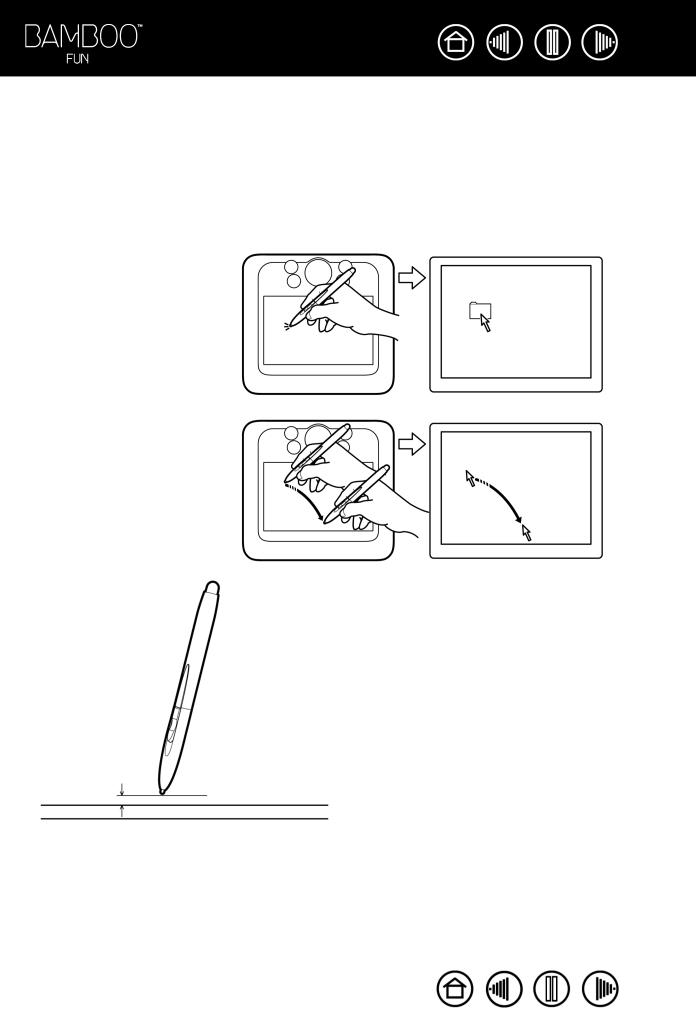
Contents Index
11
POINTING
The Bamboo Fun pen positions the pointer (or cursor) on your screen. You can position the screen cursor two different ways, like a pen (PEN MODE) or like a mouse (MOUSE MODE).
•In PEN MODE, the tablet active area is a mapped representation of your computer screen; wherever you place the pen on the tablet, the screen cursor will jump to the corresponding point on the screen. This is the default setting for the pen.
•In MOUSE MODE, the default setting for the cordless mouse, you move the cursor with a “pick up and slide” motion similar to using a traditional mouse.
Try moving the screen cursor by lifting the pen and placing the pen tip in a new location on the tablet. The cursor instantly jumps to the new location.
5 mm (0.20 inch)
When positioning the screen cursor and operating a pen button, the pen tip needs to be within 5 mm (0.20 inch) of the tablet surface. You do not need to touch the tablet with the pen tip in order to move the screen cursor or use a pen button.
The cordless mouse works similarly to the pen, and works only over the active area of the tablet.
Hints:
•If you find that using a pen is somewhat difficult, try the eye-hand coordination exercise.
•Pointing is easier when you orient the tablet so the screen cursor follows the same direction as your hand movements on the tablet.
Contents Index
11
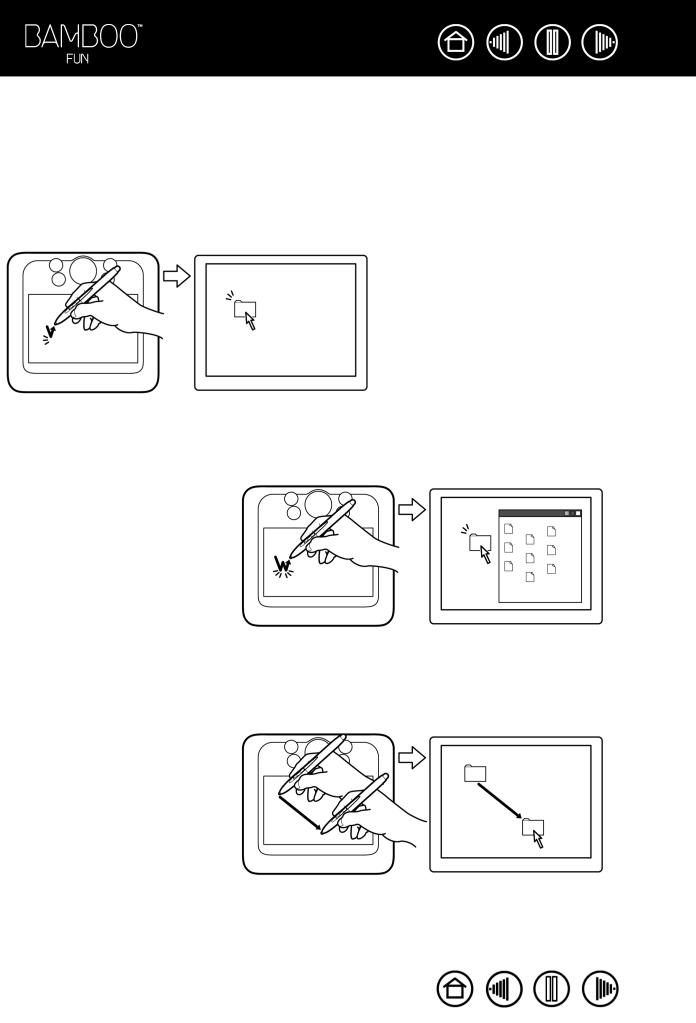
Contents Index
12
CLICKING
Click to highlight or select something on the screen. Double-click to open it.
Clicking. Tap the pen tip once on the tablet, or press the pen tip on the tablet with enough force to register a click. (If CLICK SOUND is selected in the Pen Tablet control panel and your computer speakers are on, then you will hear a “click” sound when the pen tip is pressed hard enough to generate a button click.) Try clicking on a folder icon by moving the screen cursor over the icon and pressing down on the pen tip. The folder should highlight when you press.
Hint: You can configure Windows to select when the pen is over an icon and to launch the icon with a single click. To turn on this feature, first open a folder.
For Windows Vista, from the ORGANIZE pull-down menu choose FOLDER AND SEARCH OPTIONS....
From the GENERAL tab select SINGLE-CLICK TO OPEN AN ITEM (POINT TO SELECT).
For other Windows versions, from the TOOLS pulldown menu choose FOLDER OPTIONS.... From the GENERAL tab select SINGLE-CLICK TO OPEN AN ITEM (POINT TO SELECT).
Double-clicking. Quickly tap the tablet twice in the same place with the pen tip. This is like clicking twice with a mouse button. Try double-clicking on a folder icon to open it.
Hint: Set a pen button to DOUBLE CLICK. This is easier than tapping twice with the pen tip.
DRAGGING
To drag, first point to an object. Then press the pen tip to the tablet and slide it across the tablet surface. The selected object will move across the screen. To select text, move the screen cursor to the beginning of a text line, then drag the pen across the tablet until the text is highlighted.
First, try moving an icon on the screen. Then, within a document, select some text by pressing and dragging the pen tip across the text.
Contents Index
12
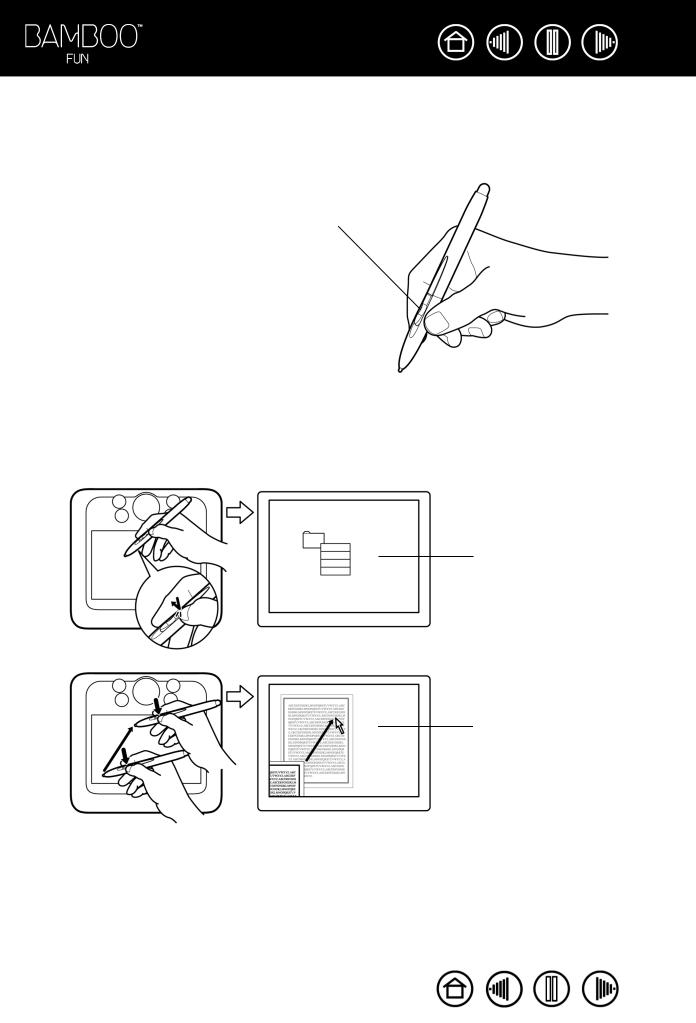
Contents Index
13
USING THE PEN BUTTONS
The Bamboo Fun pen has two buttons. Each button has a programmable function that is selected when you press the button. You can use a pen button whenever the pen tip is within 5 mm (0.20 inch) of the tablet active area. You do not have to touch the pen tip to the tablet to use a button.
The upper pen button is set to RIGHT CLICK, and the lower button is set to PAN/SCROLL by default.
•Use RIGHT CLICK to bring up application-specific or icon-specific menus.
•PAN/SCROLL lets you position a document or image in any direction within the active window by pressing the pen button and moving the pen tip across the tablet’s active area. As you move the pen tip, the document or image is repositioned to follow the direction of pen movement on the tablet. Release the pen button or lift the pen tip from the tablet surface when you are done.
In some application windows the document will precisely follow the screen cursor as you move the pen tip, while in others it will simply move in the same general direction as the screen cursor.
Hint: Set a pen button to DOUBLE CLICK. This is easier than tapping twice with the pen tip.
Example of right click on computer display.
Example of pan/scroll movement on computer display.
To assign new switch functions, see customizing the pen buttons.
Contents Index
13
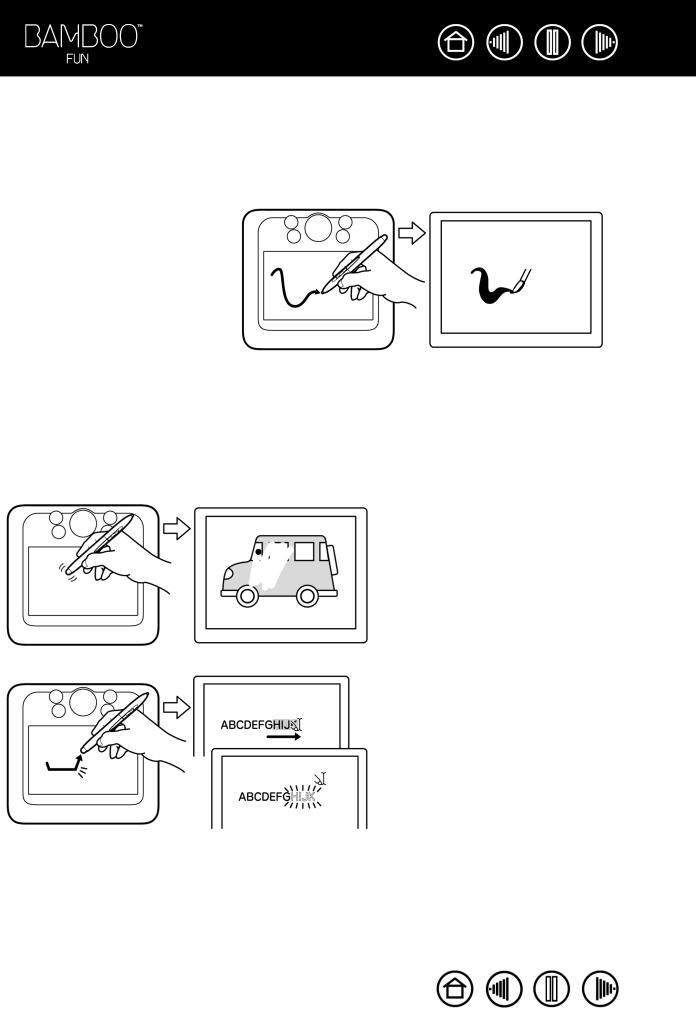
Contents Index
14
DRAWING WITH PRESSURE SENSITIVITY
The Bamboo Fun pen responds to your hand movements, enabling you to create natural-looking pen and brush strokes. Many graphics applications have drawing tools that respond to the pressure you place on the pen. The digital ink tools in Microsoft Windows Vista and Office 2007 also respond to the pressure you place on the pen.
To draw with pressure sensitivity, first select a pressure-sensitive tool from your application’s tool palette. Then draw along the surface of the tablet while applying various amounts of pressure downward on the tip of the pen. Press hard for thick lines or dense color. Press gently for thin lines or softer color.
To adjust the tip feel, see adjusting tip feel, eraser feel, and doubleclick.
Visit our web site for a list of graphics applications that support pressure. See product information.
ERASING
The Bamboo Fun pen eraser works like the eraser on a pencil.
In graphics applications that support the pen eraser, you can erase intuitively and naturally. When you use the pen eraser, the application will automatically switch to the eraser tool. In applications that support pressure sensitivity, you can select pressuresensitive tools in an application’s tool palette to vary the width and depth of your erasures as you change the amount of pressure you exert upon the pen.
For Microsoft Windows Vista and Office 2007, you can use the eraser to erase notes or sketches made with digital ink, and to select and delete text or spreadsheet cells within an application.
For more information, see adjusting tip feel, eraser feel, and double-click.
Visit our web site for a list of graphics applications that support the eraser (see product information). If the eraser is not supported in an application, you can still use the eraser for navigating, drawing, or annotation.
Contents Index
14
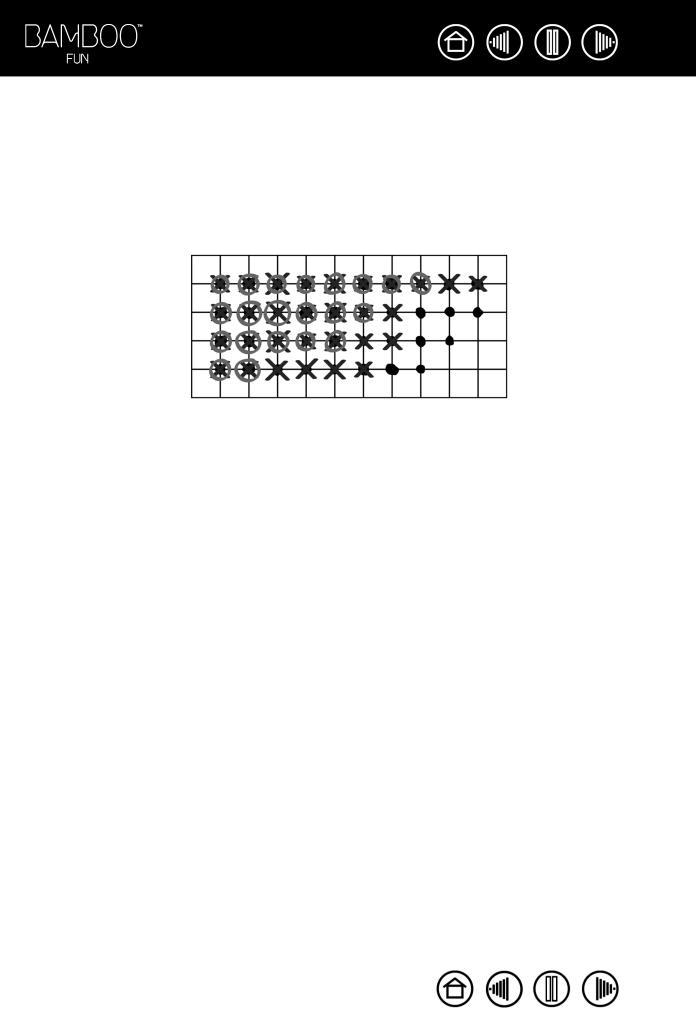
Contents Index
15
EYE-HAND COORDINATION EXERCISE
This exercise is designed to retrain your eye-hand coordination for using the pen:
1.Open any graphics application. Use the line tool to sketch a rectangular grid with line spacings of about 20-25 mm (3/4 to 1 inch). You can use your traditional mouse to do this.
2.Choose a free-hand tool in your application and use the pen to draw a dot at each grid intersection.
3.Draw an X at each grid intersection.
4.Now sketch a circle around each intersection. Your screen should look like this:
5.Clear your screen and make a simple drawing of your own. The more you use your pen, the easier drawing and navigation will become.
Contents Index
15
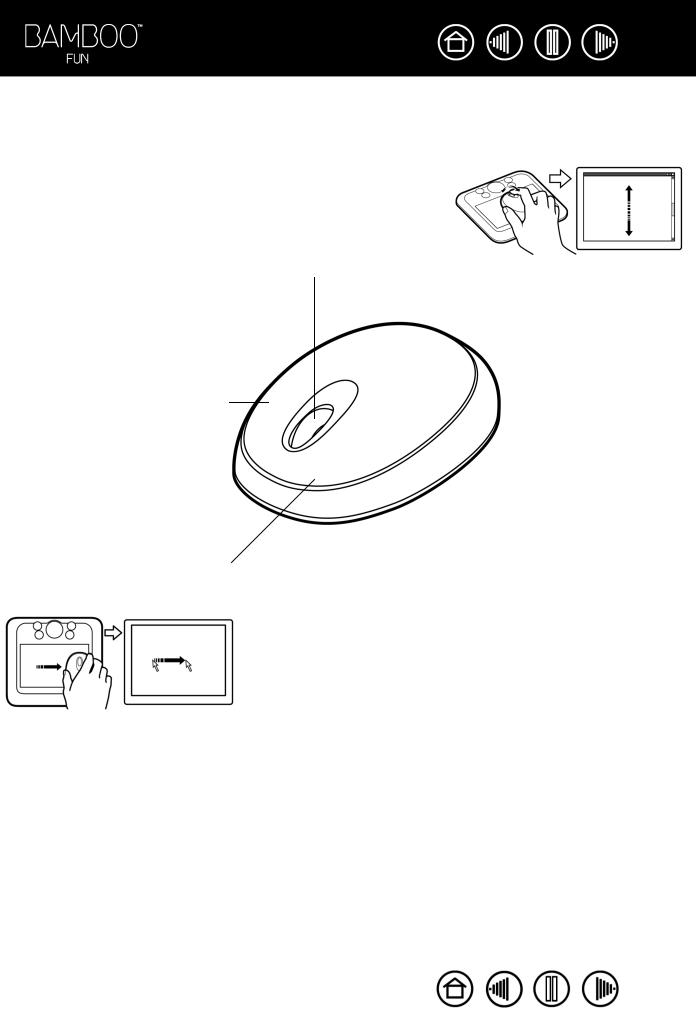
Contents Index
16
USING THE CORDLESS MOUSE
The Bamboo Fun cordless mouse is battery-free and works on your Bamboo Fun pen tablet. Note that some product configurations may not include the cordless mouse.
The fingerwheel can be rolled, or pressed for an additional button function.
•Rolling. By default, the fingerwheel is set to SCROLL 3 lines per wheel step in most windows and applications. Move the fingerwheel forward to scroll up, and back to scroll down.
•Wheel button. Press down on the wheel to perform a button click. The wheel button is set to MIDDLE CLICK by default.
The right button is set to RIGHT CLICK by default, and displays a context menu when pressed.
The left button is set to CLICK by default, and is the primary button used for selecting.
Hint: For Microsoft Office applications that support a wheel mouse, press the CTRL key and move the fingerwheel to zoom in and out.
Important: When the cordless mouse is not in use, place it on your desk. Leaving a Bamboo Fun tool on the tablet may interfere with screen cursor positioning when using other pointing devices, or may prevent your computer from going to sleep.
To adjust the mouse behavior for your preferences, see customizing the cordless mouse.
Contents Index
16
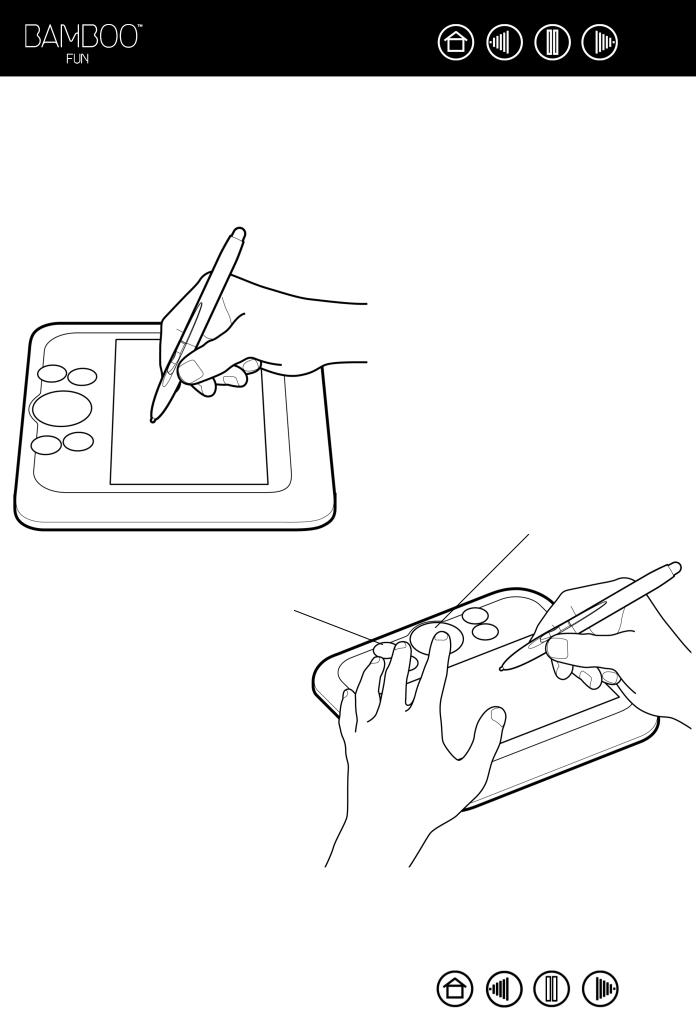
Contents Index
17
WORKING WITH THE TABLET
The middle area of the tablet is the working, or active, area for the pen and cordless mouse. Rest your hand on the tablet and then work with the pen on the active area of the tablet just as if you were using a ball point pen on a piece of paper. Wherever you place your pen on the tablet active area, the screen cursor will jump to the corresponding point on the screen. See using the cordless pen and using the cordless mouse for more information.
Your tablet also features a customizable Touch Ring and ExpressKeys for frequently used functions.
ExpressKeys. Press the customizable ExpressKeys to perform frequently used functions or keystrokes, or to emulate button clicks or modifier keys.
ExpressKeys can be used separately or in combination with your Bamboo Fun pen. For example, you can set a pair of keys to
commonly used keystrokes, such as [ and ] to decrease and increase your brush size in Photoshop. In this manner you can change the properties of your pen as you work without removing your hands from the tablet.
By default, the upper keys are set to move FORWARD (right key) or BACK (left key) within your Internet browser.
On Windows Vista systems the lower left button defaults to JOURNAL when the Journal application is available. Otherwise, the button is set to SHOW
DESKTOP.
For the lower right button, the default condition is SWITCH APPLICATION on Windows systems and EXPOSÉ on Macintosh systems.
Touch Ring. Slide your finger over the Touch Ring to zoom or scroll. By default the Touch Ring is set for zoom functionality.
•Move your finger clockwise to zoom in on a document or image.
•Move your finger counterclockwise to zoom out.
See also customizing the tablet functions.
Contents Index
17
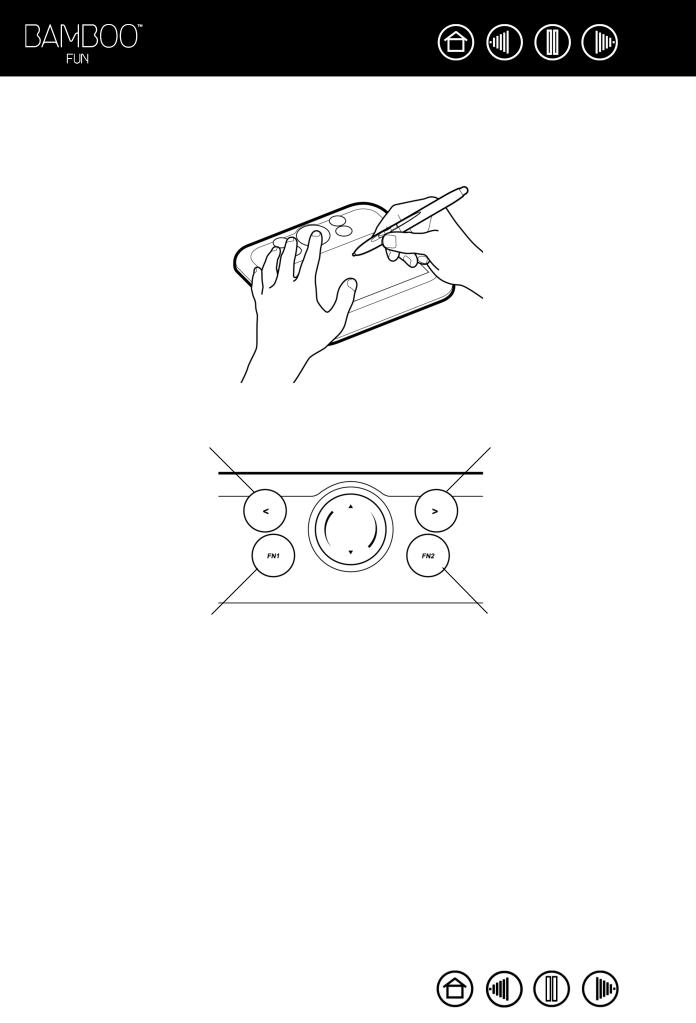
Contents Index
18
USING THE EXPRESSKEYS
Press the ExpressKeys to perform frequently used functions. You can do this with your secondary hand while using your primary hand to work with your Bamboo Fun pen on the tablet. The ExpressKey default settings will vary depending on which operating system you are using.
BACK |
FORWARD |
• |
Windows Vista (Aero): RUN MICROSOFT |
• |
Windows Vista (Aero): |
|
JOURNAL |
|
APPLICATION SWITCH (FLIP 3D) |
• |
All others: SHOW DESKTOP |
• |
Windows Vista, XP, or 2000: |
|
|
|
APPLICATION SWITCH |
|
|
• |
Macintosh: EXPOSÉ |
The ExpressKeys are fully customizable. Consider some of these alternate ways of using the ExpressKeys:
•Set a key to a commonly used keyboard shortcut.
•Set a key to launch a commonly used file or application, such as your email program.
•Choose from any of the other available functions.
Note also that the tablet ExpressKeys are chordable, which means you can operate them simultaneously. For example, if you program one key to simulate the CTRL key and another to simulate an ALT keystroke, when you press both keys a CTRL+ALT is simulated. An ExpressKey which is set to a modifier or button click function can be pressed simultaneously while using the pen to modify the pen function.
See customizing the tablet functions for more details on the available settings.
Contents Index
18
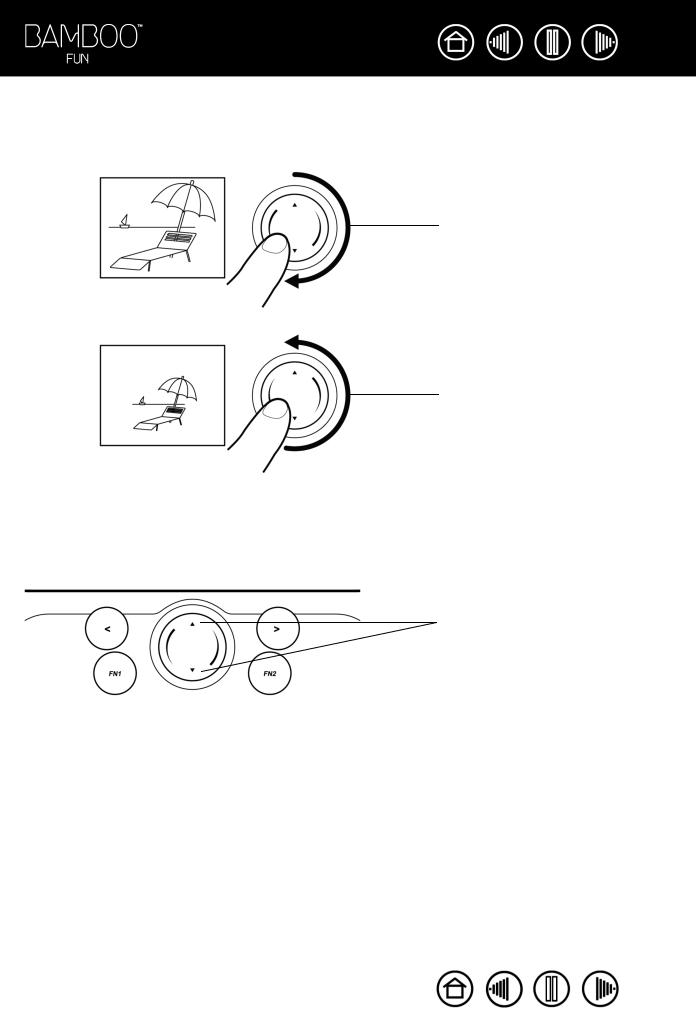
Contents Index
19
USING THE TOUCH RING
The Touch Ring lets you scroll and zoom in your current document.
•Zooming: Slide your finger clockwise to zoom in, and counterclockwise to zoom out.
Example of zooming in.
Example of zooming out.
•Continuous scrolling: Press and hold your finger on the up arrow to continuously scroll up. Press and hold your finger on the down arrow to continuously scroll down.
•Single step scrolling: Tap your finger on the up arrow to scroll up one step at a time. Tap your finger on the down arrow to scroll down one step at a time.
Press and hold here for continuous operation, or press and release for single step operation.
You can also set the Touch Ring to scroll when you slide your finger around the ring. See customizing the tablet functions.
Contents Index
19
